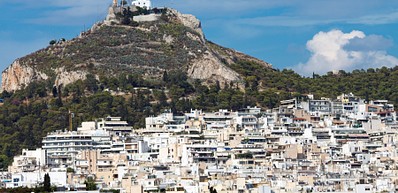
-
![Acropolis Museum, Athens]() Provided by: Haris vythoulkas/Shutterstock.com
Provided by: Haris vythoulkas/Shutterstock.com

Our travel guides are free to read and explore online. If you want to get your own copy, the full travel guide for this destination is available to you offline* to bring along anywhere or print for your trip.
*this will be downloaded as a PDF.Price
€4,95
Acropolis Museum
The guide was updated:Well worth visiting and right at the foot of the Acropolis lies the new Acropolis Museum which provides valuable insights into the Greek mythology and Greek history. The museum restaurant offers panoramic views of the Acropolis and a 700 square metre public terrace commanding a breathtaking view of the historic hills of Athens.
Useful Information
- Address: Dionysiou Areopagitou 15, Athens
- Phone: +30 210 9000 900
- Email: info@theacropolismuseum.gr

From USD 50
Lowest price guaranteedDigital Travel Guide Download
Our travel guides are free to read and explore online. If you want to get your own copy, the full travel guide for this destination is available to you offline* to bring along anywhere or print for your trip.
*this will be downloaded as a PDF.Price
€4,95

The Parthenon, the temple of Athena, is a UNESCO World Heritage Site and the major attraction of Athens. The Erechtheion displays the statues of the female Caryatids, though the original statues have been replaced by copies because of air pollution (the originals are in the new Museum).
On the southern slopes of the Acropolis lies the Odeon of Herodes Atticus, a Roman theatre with room for as many as 5,000 spectators. It is used during the annual Athens Festival for world-class ballet and music performances. The Theatre of Dionysus lies beside Herodes Atticus, and almost all the tragedies and comedies of Ancient Greece were written for this theatre.
Bookable
Read more

Roman Agora
In antiquity, the Agora played a major role as both a marketplace and a political centre. The Agora is dominated by the Stoa of Attalos and the Theseion, or Hephaisteion, dedicated to the God of metalworking and also to Theseus, one of the heroes of Greek mythology.
Read more

Acropolis Museum
Well worth visiting and right at the foot of the Acropolis lies the new Acropolis Museum which provides valuable insights into the Greek mythology and Greek history. The museum restaurant offers panoramic views of the Acropolis and a 700 square metre public terrace commanding a breathtaking view of the historic hills of Athens.
Bookable
Read more

Plaka Neighbourhood
Plaka feels like a small village at the very heart of the vibrant Greek capital. You will most likely walk through the neighbourhood on your way to or from the Acropolis, but it's worth more than a passing glance. Plaka has a soul of its own and its small streets, flowery corners and pretty stairs brim with countless coffee shops.
Bookable
Read more

Panathenaic Stadium
The Panathenaic Stadium or Kallimarmaro was built in 330 BC and renovated for the 1896 Olympic Games. It is the world's oldest stadium which is still in use, and the only one in the world entirely built in white marble. It is from here that the Olympic Flame is delivered to all the Olympic games.
Bookable
Read more

National Archaeological Museum
The National Archaeological Museum, in Exarchia, is home to Ancient Greece’s most spectacular pieces. One room contains Schliemann’s finds from Mycenae, another has the famous frescoes from Santorini on display. There is also a fine collection of idols from the Cyclades and ceramics from all parts of the Mediterranean.
The star of the museum is the Antikythera Mechanism — an ancient hand-powered orrery, described as the oldest example of an analogue computer used to predict astronomical positions and eclipses decades in advance. This scientific marvel is dated somewhere between 205 and 60 BCE.
Bookable
Read more

Benaki Museum of Greek Culture
Benaki is a history museum with Greek art and objects from the Stone Age right up to the War of Independence against the Ottoman Empire. It presents its pieces over three floors and apart from seasonal exhibitions, the museum offers events, courses and publications to educate audiences of all ages. The annexed cafe-restaurant welcomes you in a relaxed ambience where to enjoy dinners, lunches or breaks before exploring the museum.
Read more

Glyfada & the Seaside
Breath in the maritime air around Glyfada, a pretty beach town with many restaurants, shops, bars and cafes, accessible from Athens by bus and tram. In Glyfada and further on the Athens Riviera you will find many beaches, ideal for swimming or sunbathing.
Read more

Mount Lycabettus
Mount Lycabettus (in Greek: Lykavittos, Λυκαβηττός) sits right in the centre of Athens, rising 277 meters (908 feet) above sea level. Getting yourself up to this altitude gives you an exquisite 360° view over Athens, the Aegean sea and the ships in Piraeus. When the sky is clear, you can see all the way to the mountains in Peloponnese. As well as views, there is also a chic cafe-restaurant, a 19th century Chapel and an amphitheatre.
Read more

Philopappos Hill
For a nice walk or picnic a bit outside the busy streets and squares of central Athens you can head to the Philopappos Hill. It offers a great view over the city and maybe the best view of the Acropolis, just far enough to embrace it all while avoiding the tourists crowd and close enough to see the beauty of its architecture.
Read more

Temple of Hephaestus
The Temple of Hephaestus is a well-preserved ancient Greek temple built in 450 BC, dedicated to the God Hephaestus, the protector of blacksmiths, craftsmen, artisans, sculptors, metals, metallurgy, fire and volcanoes. This may be one of the most well-preserved temples, not only in Greece, but in all of Europe.
Read more

Exarcheia
Exarcheia, Athens' anarchist neighbourhood, has seen the youth of the city rise up against power and injustice many times, and it has also unfortunately been the theatre of political drama.
Even though Exarcheia has kept intact its rebellious soul and keeps on its walls traces and street art as testimony of its agitated past — the area has softened a bit and has become somewhat hipster. It is a cool place to hang out, go for a walk, meet locals, and have a coffee or a drink around the main square.
Read more

Erechtheion
Named after Erechtheus, king of Athens and foster son of Athena, the Erechtheion is an ancient Greek temple on the north side of the Acropolis dedicated to both Athena and Poseidon. This intricate temple was designed to accommodate the radically uneven ground on the site and to avoid disturbing sacred shrines like the altars to Poseidon, the sacred olive tree, a well containing sea water, the tomb of Kekrops, and the Pandrosion sanctuary.
Read more

Museum of Cycladic Art
The gorgeous and elegant Museum of Cycladic Art contains more than 3,000 artefacts of Cycladic, Ancient Greek and Cypriot art pieces, on display over four floors. This is an interesting museum to visit to get a greater understanding of this colourful culture.
Read more

Megaron Concert Hall
The Megaron, Athens' Concert Hall, was inaugurated in 1991 and it now houses four halls offering a variety of musical performances. It is famous for its top-notch spectacles and an impressive acoustic.
Read more

Temple of Athena Nike
Temple of Athena Nike is located on the south-west corner of the Acropolis. It is one of the earliest pieces of the Ionic order, one of Greece's three classical architectural styles. Celebrating Athena The Victorious, it is anchored in Greek mythology.
Read more

Monastiraki Neighbourhood
Monastiraki, right under the Acropolis, is one of the oldest neighbourhoods of Athens and considered the heart of the city. Nowadays, it houses the local "Flea Market" as well as shops, cafes, eateries and touristic stores. It is one of the nicest areas to walk in but also one of the most crowded.
Read more

Old Monastery of Daphni
The Old Daphni Monastery was originally founded and built at the end of the 6th century, to the west of today's Athens. Surrounded by defence mechanisms, the monastery was extended with additional construction over time. The interior holds detailed mosaics and the complex is now a designated UNESCO World Heritage Site, which is worth the little detour by public transport.
Read more

Odeon of Herodes Atticus
Part of the Acropolis, the Odeon of Herodes Atticus is a stone Roman theatre. The structure was completed in 161 AD only to become a ruin a hundred years later. The amphitheatre went through a series of renovations throughout the centuries and now host a wide variety of cultural events. The venue is widely known by locals as simply Herodeon.
Read more

Anafiotika
Part of Plaka, Anafiotika is a scenic neighbourhood of Athens on the northern slope of the Acropolis. Part of this area was destroyed in 1950s for archaeological research. Today, there are only 45 old houses remaining, on the little unnamed streets from Stratonos to the Acropolis rock. It's a great example of the typical Cycladic architecture that gives visitors the feel of Greek islands in the heart of the city.
Read more

Hellenic Motor Museum
Who knew that for a brief moment in the 1980s Greece had a flourishing auto industry? The Hellenic Motor Museum is the place to see a collection of historic and iconic cars, divided into antique, veteran, vintage, classic, modern and contemporary. The 1906 cherry red Model N Ford is the star of the show.
Read more

Byzantine & Christian Museum
The Byzantine and Christian Museum in Athens houses more than 25,000 artefacts of Early Christian, Byzantine and Medieval times. Byzantine culture was almost entirely concerned with religious expression, so in the museum's collection you'll find pictures, scriptures, relief carvings, frescoes, pottery, fabrics, manuscripts.
Read more

Athens War Museum
The Athens War Museum is run by the Greek Armed Forces. The exhibitions cover the history of war in all ages, from Mycenaean conflicts all the way to the present day. Great displays of battle grounds, weapons, uniforms, heroic figures and personal items.
Bookable
Read more

Psyrri Neighbourhood
Psyrri is a gentrified neighbourhood known for its bohemian cafe-bars, live music taverns, artisanal boutiques, exotic spice bazaars and small number of hotels. It's one of the oldest quarters of Athens and used to be regarded as a dodgy place until the early 90s.
In the late 19th century, Psyrri used to be the ‘Bronx’ of Athens. ‘Koutsavakides’ (‘hobbler dudes’ in Greek) would walk the streets in their jackets worn on one sleeve and bully locals. You'll see this archetypical character show up in street art all over the neighbourhood.
Bookable
Read more

Dora Stratou Dance Theatre
The Dora Stratou Dance Theatre is situated on the slopes of Philopappou Hill, just opposite the Acropolis Hill. The theatre gives 80-minute performances of dances from many parts of Greece and the islands. For a more immersive experience, take part in dancing classes, lectures and research programs all year round. In the summer, classes are often taught in English. Absolute beginners are welcome!
Bookable
Read more

